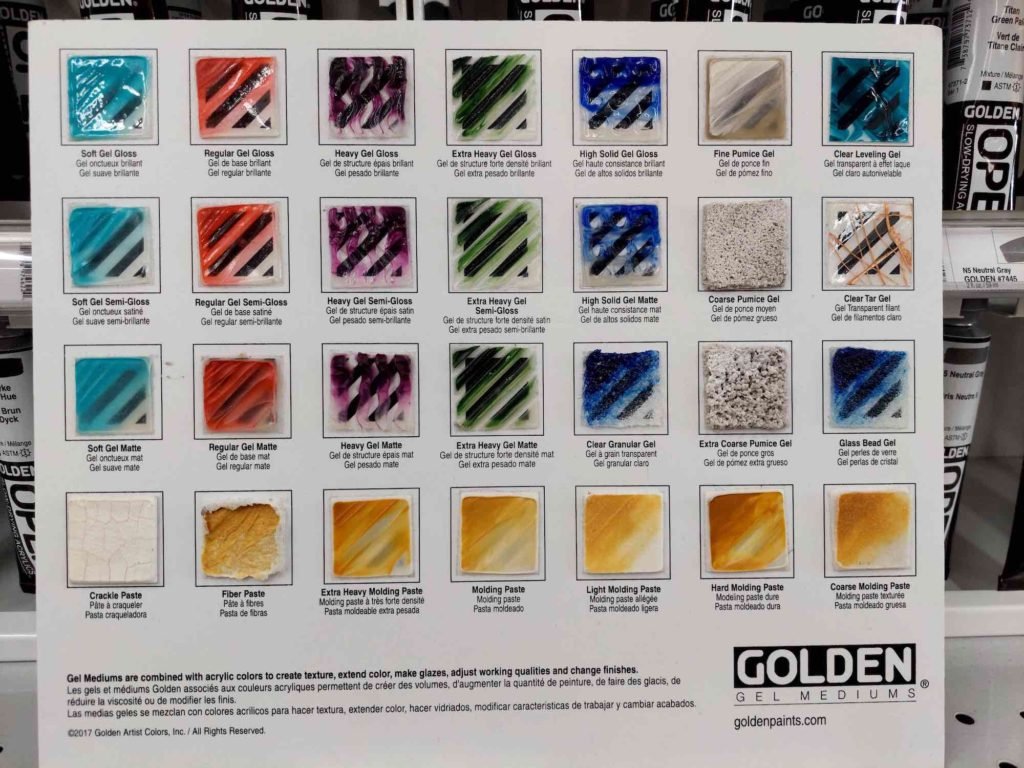
I took this photo at my local art store. Charts like this – with real product results – are so handy!
As a painter, it is important to understand the different mediums that can be used to modify the consistency and finish of acrylic paints. Two of the most common mediums used with acrylic paints are water and acrylic mediums. Both have their own unique characteristics and uses, and it is important to understand the differences between them.
Using Water:
- Water is the simplest and most common medium used with acrylic paints. It is used to thin the paint, making it easier to spread and work with.
- Water can affect the drying time of the paint, making it dry slower since more water has to evaporate.
- When using water with acrylic paints, it is important to remember that it will dilute the pigment, making the colors less intense.
- Water is a great medium for underpainting, as it allows you to build up the layers of paint gradually, without creating a heavy and opaque application.
- The downside to using TOO MUCH water is that it will start to break down the paint itself.
Using Acrylic Mediums:
- Acrylic mediums are specialized additives that are specifically designed to modify the consistency and finish of acrylic paints.
- There are a variety of acrylic mediums available, including gels, pastes, and fluid mediums. Each has its own unique characteristics and uses, and can be used to create different effects in your paintings.
- Acrylic mediums are used to create a smoother and more fluid consistency, making it easier to work with the paint.
- Unlike water, acrylic mediums do not dilute the pigment, meaning the colors will remain intense and vibrant.
- Acrylic mediums can be used to create a glossy or matte finish, depending on the medium used and how it is applied.
Types of Acrylic Mediums:
Consistency –
High flow- used for pouring.
Extender – like high-flower – it thins and is translucent. Extends the pigment (more paint for less money), increases flexibility
Soft – spreads easily, will
Regular or Heavy – similar to the same thickness of a heavy-body paint
Extra Heavy – thicker than regular paint – helps add thickness
Sheen
Gloss – shiny
Matte – non-shiny
Texture
Molding Paste – thicker, can create a smooth surface, or be used to create texture in strokes
Gel – Options start thinner than a regular heavy-body paint. Can help create glazes. And, then more heavier gel options build up until you can get a product that can hold peaks and tool marks. Can be used like a clear glue for collages.
Speciality textures – such as crackle, pumice, fiber. Add these types of textures to the paint.
| Often mediums are a combination of the above. For example, a glossy gel, or a matte molding paste. |
Water and acrylic mediums both have their own unique characteristics and uses, and it is important to understand the differences between them. Water is a simple and straightforward medium, but it can affect the drying time and intensity of the colors. Acrylic mediums are specialized additives that are specifically designed to modify the consistency and finish of acrylic paints, and can be used to create a variety of effects in your paintings. Ultimately, the choice between water and acrylic mediums will depend on your personal preferences, as well as the type of painting you are working on. Usually, you will end up using a combination of both. Try out different mediums – I usually wait for a sale to try out a new product, or share with an nearby art pal.
